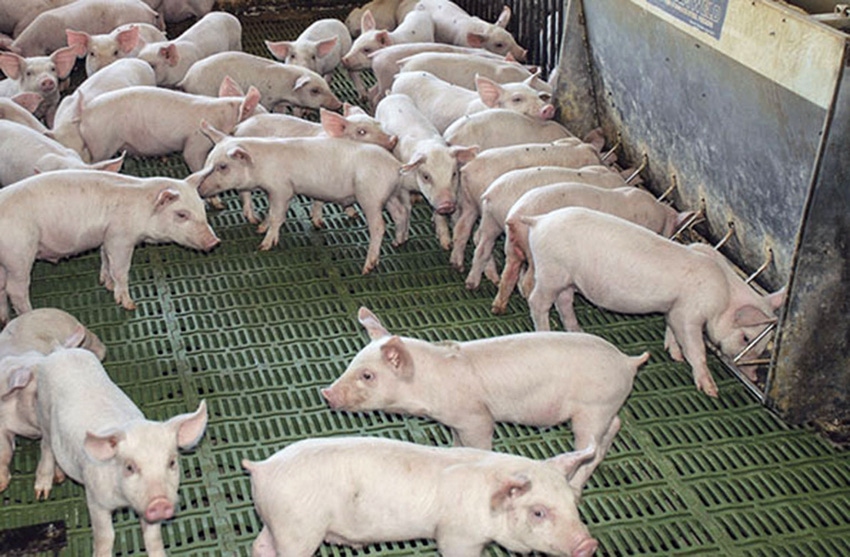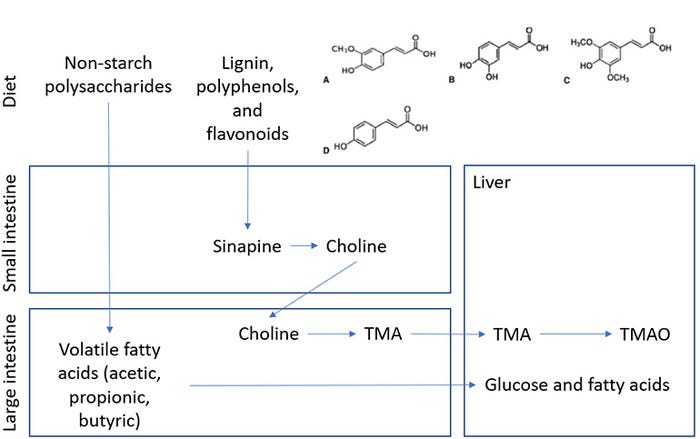Are the benefits of dietary fiber all about the carbohydrates?
Many phytochemicals or their metabolites may have beneficial effects on a pig's health.
December 12, 2019

In a previous article (June 20, 2018) we discussed that different feed ingredients high in dietary fiber have beneficial effects such as decrease of diarrhea in young pigs or satiety in sows. Dietary fiber also has detrimental effects such as reduced diet digestible energy and reduced carcass yield.
Likewise, other authors have discussed that dietary fiber is not an inert component of the diet, but that fiber affects various aspects of gut physiology, structure and function (Patience, March 1, 2018). These articles and the National Research Council 2012 defined dietary fiber as the carbohydrates in the diet that are resistant to digestion by enzymes from the pig's small intestine.
Lignin which is not a carbohydrate is usually overlooked or simply regarded as an inert portion of the fiber. Recent data from our own research suggest that lignin and other components of fiber are not as inert as thought.
Rapeseed (Brassica sp.) meal is considered an economical source of amino acids that compete with soybean meal. However, rapeseed meal contains greater concentration of dietary fiber and phytochemicals with negative impact on growth performance of pigs. Many of the phytochemicals in rapeseed meal are derivatives of cinnamic acid such as ferulic acid, caffeic acid, p-coumaric acid and sinapic acid which are present in rapeseed meal in greater concentration than soybean meal (Figure 1). However, the metabolic fate of these phytochemicals along with the distribution in the intestinal tract, liver and serum have not been described in pigs.

The concentration of metabolites of 20 pigs fed rapeseed derived ingredients was compared with that of pigs fed soybean meal (Chen et al. J. Agric. Food Chem 2019, 67:7748). Rapeseed meal contained greater concentration of sinapine while soybean meal contained greater concentration of Daidzein. Hydrolysis of sinapine in the small intestine of pigs fed rapeseed derived ingredients rendered choline. Subsequently, pigs fed rapeseed derived ingredients had greater concentration of trimethylamine (TMA) which is a product of microbial metabolism of choline in the large intestine of pigs. This TMA is the product of choline metabolism by Clostridium and Eubaterium strains that contain TMA-forming enzymes.
The TMA that was absorbed in the intestine was observed to be oxidized in the liver to trimethylamine oxide (TMAO). Interestingly, TMAO when supplemented in the diet of nursery pigs has been observed to increase the apparent digestibility of crude fat and increase carcass lean deposition in growing pigs (Overland et al. J. Anim. Sci. 1999:2143).
Cereal grains, like corn, also contain significant concentration of cinnamic acid and its derivatives of which ferulic acid is the most prevalent (Bach Knudsen et al. Mol. Nutr. Food Res. 2017, 61:1-15). In contrast to rapeseed meal, ferulic acid in corn and corn coproducts is linked to cell wall structures such as arabinoxylans, cellulose, proteins and lignin via ester bonds. These cinnamic acid derivatives from cereal grains are also thought to have metabolic impact including health benefits associated to consumption of whole grains in humans.
Bioavailability of ferulic acid in wheat bran has been demonstrated to increase by 2-3-fold with use of esterase enzymes resulting in an increased absorption in the small intestine, increased post-prandial blood concentration and increased anti-inflammatory properties (Anson et al. J. Nutr. 2011, 141:137-143). Likewise, bioavailability of polyphenols increases when components of the diet are ground, and this increased bioavailability can improve the beneficial effects of fiber such as the antioxidant function (Gu et al. J Functional Foods 2019, 57:211-221).
Consequently, processing oilseed and cereal coproducts may target increase in digestibility of dietary fiber as described in previous articles (Urriola et al., National Hog Farmer, Oct. 18, 2018; Perez-Palencia et al., National Hog Farmer, July 18), but it may also target to increase the bioavailability of phytochemicals that may have beneficial impact on pig health and performance.
In conclusion, dietary fiber in many feed ingredients have associated components such as phytochemicals and polyphenols that are actively absorbed in the small intestine, actively metabolized by bacteria in the large intestine and metabolized in the liver. Many of these phytochemicals or their metabolites may have beneficial effects on pig's health, but we need to find methods to improve their bioavailability to harness their benefits.
Sources: Pedro E. Urriola and Jerry Shurson, who are solely responsible for the information provided, and wholly own the information. Informa Business Media and all its subsidiaries are not responsible for any of the content contained in this information asset.
You May Also Like



